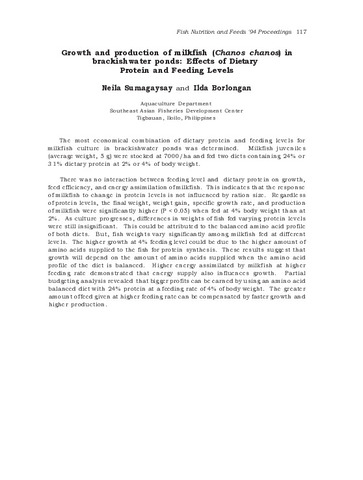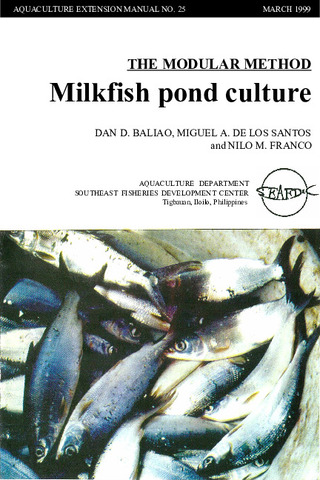Growth and production of milkfish (Chanos chanos) in brackishwater ponds: effects of dietary protein and feeding levels
- Global styles
- MLA
- Vancouver
- Elsevier - Harvard
- APA
- Help
Share
Abstract
The most economical combination of dietary protein and feeding levels for milkfish culture in brackishwater ponds was determined. Milkfish juveniles (average weight, 5 g) were stocked at 7000/ha and fed two diets containing 24% or 31% dietary protein at 2% or 4% of body weight.There was no interaction between feeding level and dietary protein on growth, feed efficiency, and energy assimilation of milkfish. This indicates that the response of milkfish to change in protein levels is not influenced by ration size. Regardless of protein levels, the final weight, weight gain, specific growth rate, and production of milkfish were significantly higher (P < 0.05) when fed at 4% body weight than at 2%. As culture progresses, differences in weights of fish fed varying protein levels were still insignificant. This could be attributed to the balanced amino acid profile of both diets. But, fish weights vary significantly among milkfish fed at different levels. The higher growth at 4% feeding level could be due to the higher amount of amino acids supplied to the fish for protein synthesis. These results suggest that growth will depend on the amount of amino acids supplied when the amino acid profile of the diet is balanced. Higher energy assimilated by milkfish at higher feeding rate demonstrated that energy supply also influences growth. Partial budgeting analysis revealed that bigger profits can be earned by using an amino acid balanced diet with 24% protein at a feeding rate of 4% of body weight. The greater amount of feed given at higher feeding rate can be compensated by faster growth and higher production.
Description
Abstract only
Type
Conference paperCollections
Related items
Showing items related by title, author, creator and subject.
-
Series: Aquaculture extension manual; No. 25
The modular method: Milkfish pond culture
Baliao, Dan D.; de los Santos, Miguel A.; Franco, Nilo M. (Aquaculture Department, Southeast Asian Fisheries Development Center, 1999)The modular method of milkfish culture (Chanos chanos) described in the manual is an improvement over the traditional extensive method. The manual is intended for the use of fish farmers and aquaculturists, extensionists, ... -
Evaluation of organic and inorganic fertilizers in brackishwater milkfish ponds
Bombeo-Tuburan, Isidra; Agbayani, Renato F.; Subosa, Precilla F. (Elsevier, 1989)The study was conducted in twelve 144-m2 ponds to evaluate the effect of different organic and inorganic fertilizers on the growth, survival, gross production, and profitability of marketable milkfish. The ... -
Milkfish breeding and hatchery technology at SEAFDEC/AQD
Unknown author (Aquaculture Department, Southeast Asian Fisheries Development Center, 1999)Describes the techniques already adopted by the private sector: broodstock management, broodstock diet, commercial fry production, live transport, and larval diet. A list of AQD research publications on milkfish is included.







